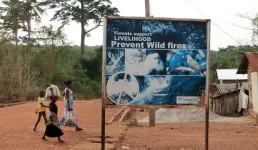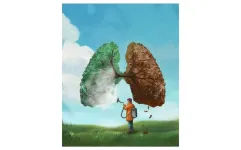(Press-News.org) Researchers at the U.S. Department of Energy’s National Renewable Energy Laboratory (NREL) have successfully leveraged robotic assistance in the manufacture of wind turbine blades, allowing for the elimination of difficult working conditions for humans and the potential to improve the consistency of the product.
Although robots have been used by the wind energy industry to paint and polish blades, automation has not been widely adopted. Research at the laboratory demonstrates the ability of a robot to trim, grind, and sand blades. Those necessary steps occur after the two sides of the blade are made using a mold and then bonded together.
“I would consider it a success,” said Hunter Huth, a robotics engineer at NREL and lead author of a newly published paper detailing the work. “Not everything operated as well as we wanted it to, but we learned all the lessons we think we need to make it meet or exceed our expectations.”
The paper, “Toolpath Generation for Automated Wind Turbine Blade Finishing Operations,” appears in the journal Wind Energy. The coauthors, all from NREL, are Casey Nichols, Scott Lambert, Petr Sindler, Derek Berry, David Barnes, Ryan Beach, and David Snowberg.
The post-molding operations to manufacture wind turbine blades require workers to perch on scaffolding and wear protective suits including respiratory gear. Automation, the researchers noted, will boost employee safety and well-being and help manufacturers retain skilled labor.
“This work is critical to enable significant U.S.-based blade manufacturing for the domestic wind turbine market,” said Daniel Laird, director of the National Wind Technology Center at NREL. “Though it may not be obvious, automating some of the labor in blade manufacture can lead to more U.S. jobs because it improves the economics of domestic blades versus imported blades.”
“The motive of this research was to develop automation methods that could be used to make domestically manufactured blades cost competitive globally,” Huth said. “Currently offshore blades are not produced in the U.S. due to high labor rates. The finishing process is very labor intensive and has a high job-turnover rate due to the harsh nature of the work. By automating the finishing process, domestic offshore blade manufacturing can become more economically viable.”
The research was conducted at the Composites Manufacturing Education and Technology (CoMET) facility at NREL’s Flatirons Campus. The robot worked on a 5-meter-long blade segment. Wind turbine blades are considerably longer, but because they bend and deflect under their own weight, a robot would have to be programmed to work on the bigger blades section by section.
The researchers used a series of scans to create a 3D representation of the position of the blade and to identify precisely the front and rear sections of the airfoil—a special shape of the blade that helps the air flow smoothly over the blade. From there, the team programmed the robot to perform a series of tasks, after which it was judged on accuracy and speed. The researchers found areas for improvement, particularly when it came to grinding. The robot ground down too much in some parts of the blade and not enough in others.
“As we've gone through this research, we've been moving the goal posts for what this system needs to do to be effective,” Huth said.
The robot was not compared to how a human would perform the same functions.
Huth said an automated system would provide consistency in blade manufacturing that is not possible when humans are doing all the work. He also said a robot would be able to use “tougher, more aggressive abrasives” than a human could tolerate.
The U.S. Department of Energy’s Advanced Materials and Manufacturing Technologies Office funded the research.
NREL is the U.S. Department of Energy's primary national laboratory for renewable energy and energy efficiency research and development. NREL is operated for DOE by the Alliance for Sustainable Energy LLC.
END
NREL invites robots to help make wind turbine blades
Research enables successful automation in post-molding manufacturing operations
2024-05-02
ELSE PRESS RELEASES FROM THIS DATE:
Scent sells – but the right picture titillates both eyes and nose, research finds
2024-05-02
Scented products with relevant images on their packaging and branding, such as flowers or fruit, are more attractive to potential customers and score better in produce evaluations, new research confirms.
And such images, the researchers conclude, are particularly effective if manufacturers and marketers choose pictures that are more likely to stimulate a stronger sense of the imagined smell – for example, cut rather than whole lemons. This, they say, suggests that as well as seducing our eyes, the images are stimulating our sense of smell.
The study, published online in the International Journal of Research in Marketing, could provide manufacturers and marketers ...
Low intensity light to fight the effects of chronic stress
2024-05-02
Some neurological disorders can be improved through photobiomodulation, a non-invasive technique based on the application of low-intensity light to stimulate altered functions in specific regions of the body. Now, a study published in the Journal of Affective Disorders reveals how photobiomodulation applied to the brain-gut axis is effective in recovering some cognitive alterations and sequelae caused by chronic stress. The study opens up new perspectives for applying the technique in future therapies for the treatment of neurological diseases in patients.
The article, based on the study of laboratory animal models, ...
Wildfires in wet African forests have doubled in recent decades
2024-05-02
American Geophysical Union
Press Release 24-19
2 May 2024
For Immediate Release
This press release is available online at: https://news.agu.org/press-release/africa-forest-fires-doubled-drying
Wildfires in wet African forests have doubled in recent decades
Climate change and human activities like deforestation are causing more fires in central and west Africa’s wet, tropical forests, according to the first-ever comprehensive survey there. The fires have long been overlooked.
AGU press contact:
Rebecca Dzombak, news@agu.org (UTC-4 hours)
Contact information ...
Dietary changes may treat pulmonary hypertension
2024-05-02
Blood vessels in the lungs aren’t like the others in the body. This difference becomes clear in pulmonary hypertension, in which only the lungs’ blood vessels stiffen progressively, leading to chronic lung disease, heart failure and death. The underlying reasons for this organ-specific vessel stiffening remained a mystery until University of Pittsburgh researcher Stephen Chan and colleagues made a surprising discovery about these blood vessel cells in patients with pulmonary hypertension—they’re hungry.
Chan, Vitalant Chair in Vascular Medicine and Professor of Medicine in the Division ...
UTA scientists test for quantum nature of gravity
2024-05-02
Einstein’s theory of general relativity explains that gravity is caused by a curvature of the directions of space and time. The most familiar manifestation of this is the Earth’s gravity, which keeps us on the ground and explains why balls fall to the floor and individuals have weight when stepping on a scale.
In the field of high-energy physics, on the other hand, scientists study tiny invisible objects that obey the laws of quantum mechanics—characterized by random fluctuations that create ...
SCAI announces recipients of 2024 early career research grants
2024-05-02
Today, the Society for Cardiovascular Angiography & Interventions (SCAI) announced the recipients of the 3rd Annual SCAI Early Career Research Grants. SCAI offers this initiative to support the next generation of interventional cardiologists, providing a platform for junior-level investigators within 10 years of completing an interventional cardiology fellowship to study high-priority, clinically important topics and have their findings disseminated through various professional channels. This year’s grants are funded by support from Edwards Lifesciences, Medtronic, and Shockwave Medical.
“Research funding is often ...
AI can tell if a patient battling cancer needs mental health support
2024-05-02
Researchers at UBC and BC Cancer have developed a new artificial intelligence (AI) model that can accurately predict if a person receiving cancer care will require mental health services during their treatment journey.
The AI uses natural language processing and advanced neural networks to analyze an oncologist’s notes from their first consultation appointment with a patient. While these appointments are typically highly focused on a patient’s medical history and treatment options, the AI picks ...
ISSCR announces Hong Kong, SAR as location for its 2025 Annual Meeting
2024-05-02
The world’s leading stem cell scientists will convene in Hong Kong, SAR, 11-14 June 2025 for the International Society for Stem Cell Research (ISSCR) 2025 Annual Meeting, illuminating the future of stem cell science and highlighting the most compelling research and clinical advances of the year. The meeting is co-sponsored by The University of Hong Kong, The Chinese University of Hong Kong, and Hong Kong University of Science and Technology. The Hong Kong Innovation and Technology Commission and the Hong Kong Convention and Exhibition Centre provided significant support to enable the ISSCR to bring its hallmark event to the city of ...
Zoology: First report of wound treatment by a wild animal using a medicinal plant
2024-05-02
A wild male Sumatran orangutan (Pongo abelii) has been observed applying chewed leaves from Akar Kuning (Fibraurea tinctoria) — a climbing plant used in traditional medicine to treat wounds and conditions such as dysentery, diabetes, and malaria — to a wound on his cheek. The findings, which are published in Scientific Reports, represent the first report of suspected wound treatment by a wild animal using a plant with known medicinal properties.
Prior to this study, multiple ...
Longer interval between first colonoscopy with negative findings for colorectal cancer and repeat colonoscopy
2024-05-02
About The Study: This cohort study found that for the population without a family history of colorectal cancer (CRC), the 10-year interval between colonoscopy screenings for individuals with a first colonoscopy with findings negative for CRC could potentially be extended to 15 years. A longer interval between colonoscopy screenings could be beneficial in avoiding unnecessary invasive examinations.
Authors: Mahdi Fallah, M.D., Ph.D., of the German Cancer Research Center in Heidelberg, is the corresponding ...
LAST 30 PRESS RELEASES:
Heart-brain connection: international study reveals the role of the vagus nerve in keeping the heart young
Researchers identify Rb1 as a predictive biomarker for a new therapeutic strategy in some breast cancers
Survey reveals ethical gaps slowing AI adoption in pediatric surgery
Stimulant ADHD medications work differently than thought
AI overestimates how smart people are, according to HSE economists
HSE researchers create genome-wide map of quadruplexes
Scientists boost cell "powerhouses" to burn more calories
Automatic label checking: The missing step in making reliable medical AI
Low daily alcohol intake linked to 50% heightened mouth cancer risk in India
American Meteorological Society announces Rick Spinrad as 2026 President-Elect
Biomass-based carbon capture spotlighted in newly released global climate webinar recording
Illuminating invisible nano pollutants: advanced bioimaging tracks the full journey of emerging nanoscale contaminants in living systems
How does age affect recovery from spinal cord injury?
Novel AI tool offers prognosis for patients with head and neck cancer
Fathers’ microplastic exposure tied to their children’s metabolic problems
Research validates laboratory model for studying high-grade serous ovarian cancer
SIR 2026 delivers transformative breakthroughs in minimally invasive medicine to improve patient care
Stem Cell Reports most downloaded papers of 2025 highlight the breadth and impact of stem cell research
Oxford-led study estimates NHS spends around 3% of its primary and secondary care budget on the health impacts of heat and cold in England
A researcher’s long quest leads to a smart composite breakthrough
Urban wild bees act as “microbial sensors” of city health.
New study finds where you live affects recovery after a hip fracture
Forecasting the impact of fully automated vehicle adoption on US road traffic injuries
Alcohol-related hospitalizations from 2016 to 2022
Semaglutide and hospitalizations in patients with obesity and established cardiovascular disease
Researchers ‘listen in’ to embryo-mother interactions during implantation using a culture system replicating the womb lining
How changing your diet could help save the world
How to make AI truly scalable and reliable for real-time traffic assignment?
Beyond fragmented markets: A new framework for efficient and stable ride-pooling
Can shape priors make road perception more reliable for autonomous driving?
[Press-News.org] NREL invites robots to help make wind turbine bladesResearch enables successful automation in post-molding manufacturing operations





